

The Python Graph Gallery – Visualizing data – with Python. HTML basics - Learn web development. HTML (Hypertext Markup Language) is the code that is used to structure and display a web page and its content. For example, content could be structured within a set of paragraphs, a list of bulleted points, or using images and data tables. As the title suggests, this article will give you a basic understanding of HTML and what its function is. So what is HTML, really? HTML is not a programming language; it is a markup language, and is used to tell your browser how to display the webpages you visit. It can be as complicated or as simple as the web designer wishes it to be. My cat is very grumpy. Colorbrewer colors for use in python. Copied from. Python-igraph. Requirements On Linux (and other Unix-like systems), you will need a C and a C++ compiler, the tool make and the development header files for your version of Python.
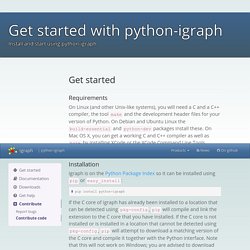
On Debian and Ubuntu Linux the build-essential and python-dev packages install these. On Mac OS X, you can get a working C and C++ compiler as well as make by installing XCode or the XCode Command Line Tools. See also the platform-specific installation instructions below. Installation igraph is on the Python Package Index so it can be installed using pip or easy_install: $ pip install python-igraph If the C core of igraph has already been installed to a location that can be detected using pkg-config, pip will compile and link the extension to the C core that you have installed. Installation on Mac OS X Instead of letting pip compile the C core for you, you can install Homebrew and the homebrew/science/igraph formula.
Installation on Windows Tutorials.
How to create Windows executable (.exe) from Python script. Calculation of sun’s position in the sky for each location on the earth at any time of day. Home > Solar tools > Sun Position Insert this map tool in your site Back to top Content | Data + Map | Chart Polar | Chart Cartesian | Table | Annual sun path | shadow | download PDF.

Sunrise and sunset times in Haifa. Search Site / Articles City / Country Social Share this page / Follow us on: Facebook TweetFollow Twitter Google+
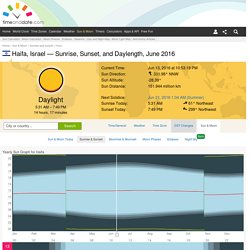
5. Built-in Exceptions — Python 3.5.1 documentation. In Python, all exceptions must be instances of a class that derives from BaseException.
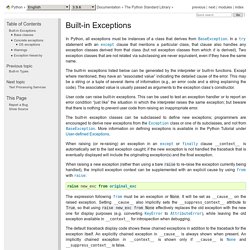
In a try statement with an except clause that mentions a particular class, that clause also handles any exception classes derived from that class (but not exception classes from which it is derived). Two exception classes that are not related via subclassing are never equivalent, even if they have the same name. The built-in exceptions listed below can be generated by the interpreter or built-in functions. 5. Built-in Exceptions — Python 3.5.1 documentation. In Python, all exceptions must be instances of a class that derives from BaseException.
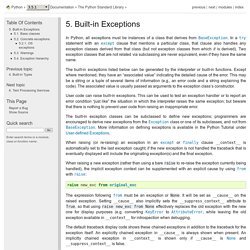
In a try statement with an except clause that mentions a particular class, that clause also handles any exception classes derived from that class (but not exception classes from which it is derived). Two exception classes that are not related via subclassing are never equivalent, even if they have the same name. The built-in exceptions listed below can be generated by the interpreter or built-in functions. Except where mentioned, they have an “associated value” indicating the detailed cause of the error. This may be a string or a tuple of several items of information (e.g., an error code and a string explaining the code). Python String strip() Method. Description The method strip() returns a copy of the string in which all chars have been stripped from the beginning and the end of the string (default whitespace characters).

Syntax. Learn Python Through Public Data Hacking. Counting occurrences in a Python list. 7 Python Regular Expressions Examples – Re Match Search FindAll. Regular expressions as a concept is not exclusive to Python at all.
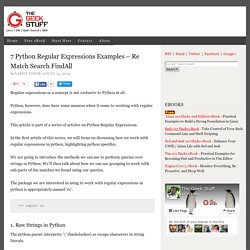
Python, however, does have some nuances when it come to working with regular expressions. This article is part of a series of articles on Python Regular Expressions. In the first article of this series, we will focus on discussing how we work with regular expressions in python, highlighting python specifics. We are going to introduce the methods we can use to perform queries over strings in Python.
We’ll then talk about how we can use grouping to work with sub-parts of the matches we found using our queries. Regular expressions 1. Special characters. The following characters are the meta characters that give special meaning to the regular expression search syntax: \ the backslash escape character.

The backslash gives special meaning to the character following it. For example, the combination "\n" stands for the newline, one of the control characters. The combination "\w" stands for a "word" character, one of the convenience escape sequences while "\1" is one of the substitution special characters. Example: The regex "aa\n" tries to match two consecutive "a"s at the end of a line, inclusive the newline character itself. Python tutorial. Deep Learning. Stopwords 0.1.3. Package Index > stopwords > 0.1.3 Not Logged In Status Nothing to report stopwords 0.1.3.

How to become a data scientist - DataRobot. Python. Learn Python - Free Interactive Python Tutorial. CS For All: Introduction to Computer Science and Python Programming. Google for Education Welcome to Google's Python Class -- this is a free class for people with a little bit of programming experience who want to learn Python.
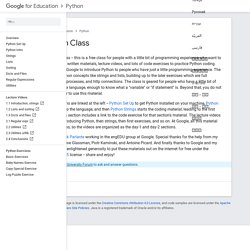
The class includes written materials, lecture videos, and lots of code exercises to practice Python coding. These materials are used within Google to introduce Python to people who have just a little programming experience. The first exercises work on basic Python concepts like strings and lists, building up to the later exercises which are full programs dealing with text files, processes, and http connections. The class is geared for people who have a little bit of programming experience in some language, enough to know what a "variable" or "if statement" is. Beyond that, you do not need to be an expert programmer to use this material. This material was created by Nick Parlante working in the engEDU group at Google.
Tip: Check out the Python Google Code University Forum to ask and answer questions.